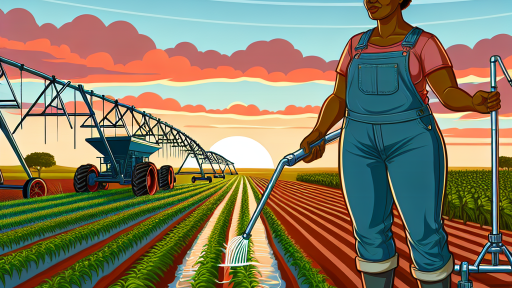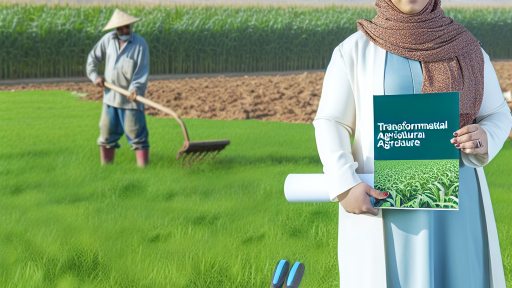Overview of Current Import/Export Tariffs Affecting Agriculture
Import and export tariffs play a crucial role in agriculture.
They influence the prices of agricultural goods domestically and internationally.
Recently, various countries have changed their tariffs on agricultural products.
This shift impacts farmers and exporters significantly.
Recent Changes in Tariffs
Countries like the United States and China have adjusted their trade policies.
These adjustments include new tariffs on essential crops.
For instance, tariffs on soybeans and corn have seen notable changes.
Such changes can hinder market access for certain products.
Impact on Farmers and Growers
Higher tariffs often lead to increased costs for farmers.
As a result, they may face reduced profit margins.
Additionally, some farmers may struggle to compete in the international market.
Consequently, they must adapt their strategies to survive.
Adaptation Strategies
Farmers can explore alternative markets for their products.
Diversifying crops may also help mitigate risks.
Investing in technology can improve efficiency and reduce costs.
Transform Your Agribusiness
Unlock your farm's potential with expert advice tailored to your needs. Get actionable steps that drive real results.
Get StartedMoreover, forming cooperatives could enhance bargaining power.
Long-Term Considerations
Understanding tariff implications is essential for future planning.
Farmers should stay informed about changes in trade policies.
They need to develop contingency plans to address unexpected shifts.
Ultimately, staying proactive will ensure their operations remain viable.
Impact of Tariffs on Farm Income and Production Costs
Understanding the Financial Implications
New import-export tariffs significantly affect farm income.
Farmers face higher costs for imported supplies and materials.
Consequently, increased production costs reduce profit margins.
Lower income directly impacts farmers’ ability to invest.
Farmers must navigate fluctuating market demands for products.
The Economic Pressure on Producers
Tariffs can lead to increased prices for consumers.
Higher prices may reduce overall demand for farm products.
This situation places additional pressure on farmers’ profits.
Farmers often need to adjust their pricing strategies.
Moreover, some producers may exit the market altogether.
Strategies for Mitigating Tariff Impacts
Farmers can adopt various strategies to counteract tariff effects.
Diversifying crop production can help mitigate risk.
Exploring alternative markets may yield better prices.
Additionally, some farmers enhance efficiency to cut costs.
Investing in local supply chains can also provide stability.
Long-Term Considerations for Farm Operations
Long-term adaptations to tariffs require careful planning.
Farmers must assess their operational models continuously.
They need to forecast future tariff changes and market trends.
This preparation allows for resilient agricultural practices.
Showcase Your Farming Business
Publish your professional farming services profile on our blog for a one-time fee of $200 and reach a dedicated audience of farmers and agribusiness owners.
Publish Your ProfileUltimately, proactive measures ensure sustainability and growth.
Strategies for Farmers to Diversify Markets in Response to Tariffs
Understanding Market Diversification
Market diversification helps farmers reduce dependency on a single market.
It spreads risk across multiple channels and consumers.
Farmers can explore both domestic and international markets.
Investing in diverse crops can attract various buyers.
Exploring Local Markets
Local markets often have a robust demand for fresh produce.
Farmers can set up farm stands or join farmers’ markets.
Community-supported agriculture (CSA) programs can also boost sales.
Engaging with local restaurants can create consistent buyers.
Utilizing Online Platforms
Online sales platforms can reach wider audiences effectively.
Farmers should consider creating their own e-commerce websites.
They can also sell through established platforms like Amazon and Etsy.
Social media marketing can increase visibility and engagement.
Targeting Export Markets
Identifying potential export markets can create new revenue streams.
Farmers should research countries that need their products.
Understanding tariffs and regulations is crucial before exporting.
Building relationships with international distributors can facilitate access.
Innovating Product Offerings
Creating value-added products can enhance profitability.
Farmers can process fruits into jams or vegetables into sauces.
Developing unique offerings caters to changing consumer preferences.
Additionally, seasonal products can attract diverse customer groups.
Implementing Sustainable Practices
Sustainable farming methods can open new market opportunities.
Consumers increasingly prefer eco-friendly products.
Certifications can differentiate products in a crowded market.
Joining local and organic networks can enhance credibility.
Networking and Collaboration
Building networks with other farmers creates sharing opportunities.
Farmers can collaborate on joint marketing efforts to reduce costs.
Participating in agricultural associations can provide valuable insights.
Networking can also lead to partnerships for larger markets.
Gain More Insights: Key Steps To Achieve Pesticide Compliance
Role of Government Support Programs in Mitigating Tariff Effects
Overview of Government Support Programs
Government support programs provide essential assistance to farmers facing new tariff challenges.
These programs often include financial aid, training, and access to resources.
Farmers can leverage these initiatives to adapt their operations effectively.
Types of Support Programs
Various types of programs exist to help mitigate tariff impacts on agriculture.
- Direct financial aid assists farmers in maintaining cash flow.
- Loan guarantees reduce the risks associated with borrowing.
- Insurance programs protect against revenue losses caused by tariffs.
These options allow farmers to make informed decisions about their operations.
Benefits of Government Involvement
Government involvement provides stability during turbulent economic times.
It helps farmers navigate the complexities of international trade.
Consequently, reduced uncertainty fosters a better business environment.
Farmers can make strategic decisions without fearing sudden loss.
Case Studies of Successful Adaptation
Several farming operations have effectively adapted to recent tariff changes.
Showcase Your Farming Business
Publish your professional farming services profile on our blog for a one-time fee of $200 and reach a dedicated audience of farmers and agribusiness owners.
Publish Your ProfileFor instance, Maple Farms utilized grant programs to diversify crops.
This diversification helped mitigate the impact of tariff-induced price fluctuations.
Similarly, Green Valley Orchards accessed low-interest loans to expand production.
These adaptations have allowed farms to thrive despite external pressures.
Future Directions for Support Programs
The need for improved support programs continues to grow.
Future initiatives should focus on long-term sustainability for agricultural businesses.
Additionally, enhancing accessibility to these programs will attract more participants.
Ongoing evaluation and adaptation of support programs are vital.
This approach ensures farmers remain resilient against future trade disruptions.
You Might Also Like: Strategies For Reducing Chemical Dependency In Agriculture
Investing in Technology to Enhance Efficiency and Reduce Costs
Adopting Precision Agriculture
Precision agriculture improves farm efficiency and productivity.
This approach utilizes technology to monitor and manage field variability.
Farmers can use GPS and sensor data to make informed decisions.
Additionally, drones can provide real-time insights into crop health.
Implementing Automated Systems
Automation reduces labor costs and increases productivity.
Investing in robotics can streamline tasks such as planting and harvesting.
These systems can operate with minimal human intervention.
Consequently, farmers can focus on strategic decision-making.
Utilizing Data Analytics
Data analytics help farmers gain valuable insights into operations.
By analyzing trends, they can optimize resource usage.
This could include monitoring soil moisture levels and nutrient needs.
Ultimately, data can drive better planning and crop management.
Embracing Smart Irrigation Techniques
Smart irrigation systems conserve water and reduce costs.
These technologies adjust watering schedules based on weather conditions.
As a result, farmers can maximize crop yield with less water.
This efficiency is crucial in areas facing water scarcity.
Leveraging Supply Chain Management Tools
Improving supply chain management enhances product distribution.
Farmers can track shipments and inventory in real-time.
This capability ensures timely deliveries and minimizes losses.
As a result, profitability can improve significantly.
Integrating Sustainable Practices
Investing in technology promotes sustainable farming practices.
For instance, using renewable energy sources can reduce costs.
This approach also attracts environmentally conscious consumers.
Consequently, sustainable farming can boost market competitiveness.
Delve into the Subject: Best Practices for Meeting Animal Welfare Standards on Farms

Building Local Supply Chains to Minimize Reliance on Imports
Understanding the Importance of Local Supply Chains
Local supply chains enhance food security and resilience.
They reduce transportation costs and time for delivery.
Moreover, local chains support regional economies.
By investing in local resources, farms create jobs in their communities.
Identifying Local Resources
Farmers should assess the availability of local raw materials.
Showcase Your Farming Business
Publish your professional farming services profile on our blog for a one-time fee of $200 and reach a dedicated audience of farmers and agribusiness owners.
Publish Your ProfileConducting a thorough analysis helps identify nearby suppliers.
Building relationships with local producers encourages collaboration.
This process fosters a community of shared economic interests.
Creating Partnerships with Local Farmers
Establishing strong partnerships can optimize local supply chains.
Farmers can share resources, such as equipment and labor.
This collaboration increases production efficiency for all involved.
Additionally, it opens doors for shared marketing efforts.
Investing in Local Processing Facilities
Local processing facilities are essential for enhancing supply chains.
They can turn raw agricultural products into market-ready goods.
Investing in processing equipment improves product handling and packaging.
This strategy boosts the value of local produce significantly.
Utilizing Technology to Enhance Efficiency
Utilizing technology streamlines supply chain management.
Farmers can adopt software for inventory tracking and logistics.
This technology helps farmers respond quickly to market demands.
Furthermore, it enhances communication with local partners.
Encouraging Community Support for Local Products
Engaging the community promotes local agricultural products.
Farmers’ markets, CSA programs, and local food festivals can raise awareness.
Community support creates demand, benefiting local producers.
Such initiatives also educate consumers about the importance of local sourcing.
Discover More: Farm-To-Table Legislation and Its Impact on Farm Revenue Streams
Evaluating Crop and Livestock Choices Based on Tariff Implications
Understanding Tariff Impacts
Tariffs can significantly affect agricultural profitability.
Farmers need to consider both import and export tariffs.
This evaluation impacts crop selection and livestock production.
Assessing Crop Choices
Crops may be affected by tariffs in various ways.
Some crops may see higher demand abroad.
Others may struggle due to increased import costs.
Farmers should analyze current market trends.
They must assess which crops align with tariff structures.
Identifying Profitable Crops
Consider crops that are less impacted by tariffs.
These include staples such as corn and soybeans.
Additionally, specialty crops may find new export opportunities.
Farmers should research potential markets abroad.
Mitigating Risks with Crop Diversity
Diversifying crop choices can help manage risk.
A varied crop portfolio can buffer against tariff volatility.
Farmers should implement crop rotation practices.
This strategy improves soil health and yields.
Evaluating Livestock Options
Livestock choices also require careful consideration.
Tariffs on imported feed can increase production costs.
Farmers should consider raising livestock that require less feed.
Grass-fed beef or other alternatives may reduce costs.
Showcase Your Farming Business
Publish your professional farming services profile on our blog for a one-time fee of $200 and reach a dedicated audience of farmers and agribusiness owners.
Publish Your ProfileUnderstanding Market Demand
Investigate the demand for various livestock products.
Some countries have a growing appetite for certain meats.
Identifying these trends can lead to better pricing strategies.
Adapting Breeding and Feeding Practices
Using efficient breeding techniques can enhance profitability.
Employing sustainable feeding practices can reduce costs.
This approach also aligns with consumer preferences.
Future Directions for Crop and Livestock Choices
Evaluating crop and livestock choices is essential in changing trade environments.
Farmers who adapt to new tariff implications can succeed.
Staying informed and flexible will drive future profitability.
Long-term Planning for Sustainable Farming Amid Fluctuating Tariffs
The Importance of Strategic Planning
Farm operations need robust strategic planning in today’s dynamic market.
Unpredictable tariffs demand adaptability and foresight from agricultural businesses.
Long-term planning can help farmers navigate these challenges effectively.
Evaluating Market Trends
Understanding market trends plays a crucial role in strategic planning.
Farmers should analyze both domestic and international market indicators.
By studying these trends, producers can make informed decisions.
Additionally, they can anticipate demand for specific crops or products.
Diversification of Crops
Diversification minimizes risks associated with tariff fluctuations.
By planting a variety of crops, farmers can stabilize income streams.
This practice reduces dependence on a single crop market.
Moreover, diverse crops can potentially meet varying market demands.
Investment in Technology
Technological advancements can enhance farm productivity and efficiency.
Investing in modern equipment aids in adapting to changing market conditions.
Automation tools can reduce labor costs and improve operational efficiency.
Furthermore, precision agriculture can optimize resource usage.
Building Strategic Partnerships
Establishing strategic partnerships strengthens farm operations.
Collaborating with other farmers and suppliers can provide mutual benefits.
These partnerships can enhance resource sharing and information exchange.
Additionally, they can create economies of scale.
Monitoring Regulatory Changes
Staying informed about regulatory changes is essential for farmers.
Understanding new tariffs and trade agreements helps in planning.
Farmers should regularly review their compliance with trade regulations.
This vigilance can ensure that they remain competitive in the market.
Financial Planning and Risk Management
Effective financial planning is crucial amid fluctuating tariffs.
Farmers should develop budget strategies that account for potential tariff changes.
Moreover, risk management strategies can protect against unforeseen market shifts.
Utilizing insurance products may help mitigate financial losses.
Additional Resources
Trump Administration Tariff Actions (Sections 201, 232, and 301 …
Importing into the United States A Guide for Commercial Importers




